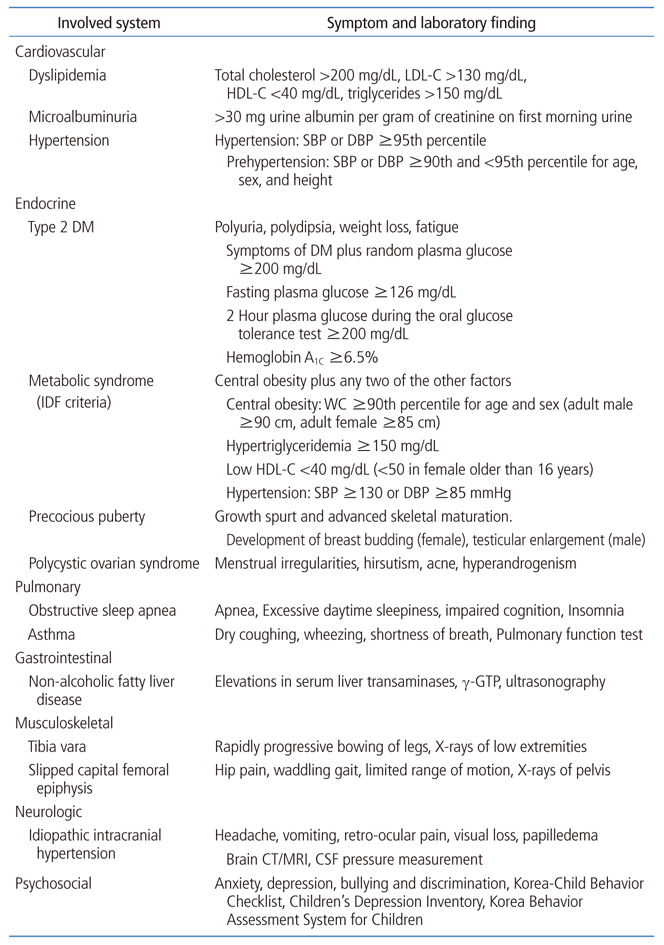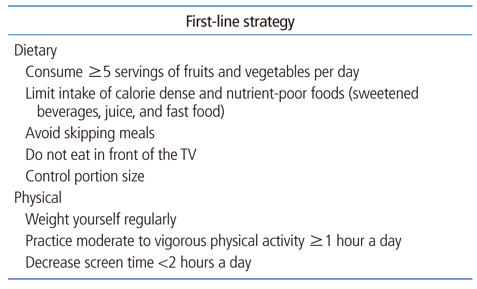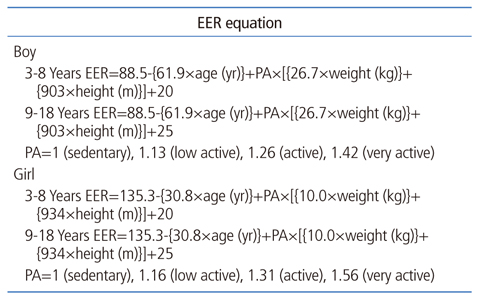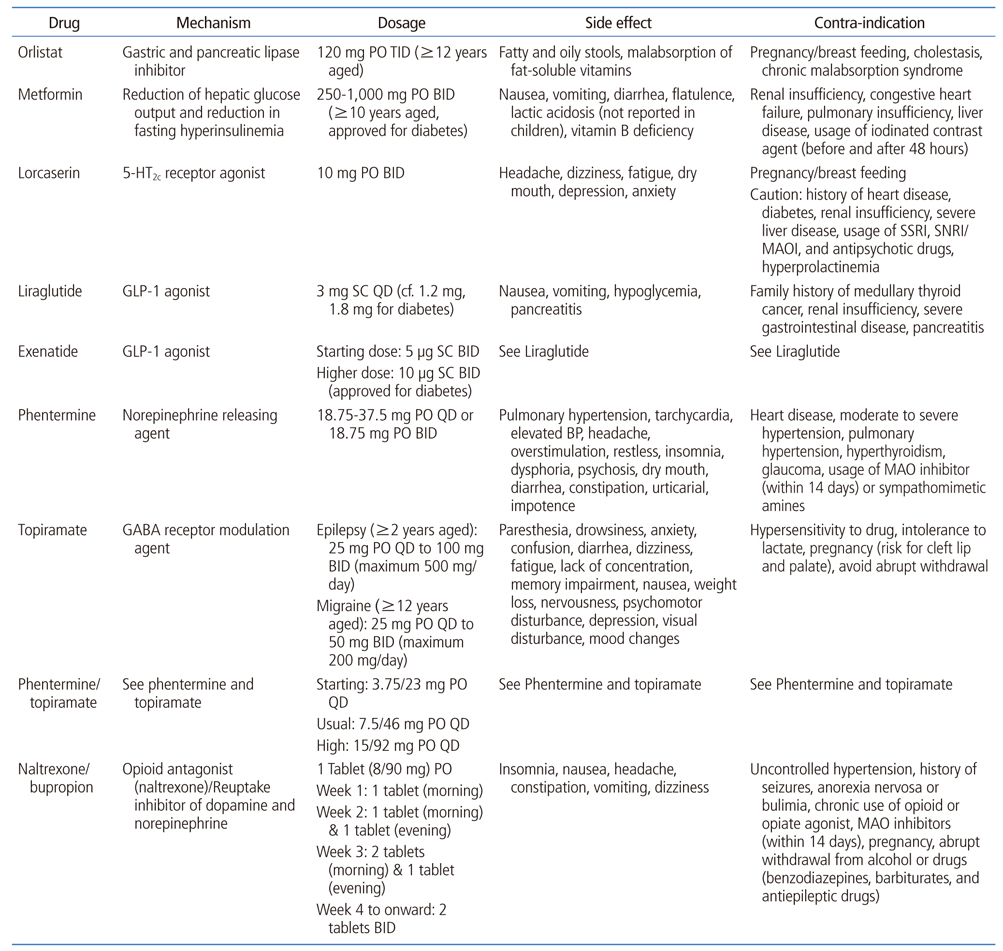 |
 |
- Search
| J Korean Med Assoc > Volume 60(3); 2017 > Article |
Abstract
Childhood obesity increases the risk of morbidity and mortality in adulthood. The epidemic of childhood obesity has become an important public health issue in Korea. Currently, the overall prevalence of obesity among Korean children and adolescents is approximately 10%, which is 5 times higher than in the late 1970s. In most cases, a positive energy balance (from excessive calorie intake and limited physical activity) combined with a genetic predisposition is considered the major cause of childhood obesity. The evaluation of obese children should focus on possible causes of weight gain, including lifestyle factors and underlying endocrine or genetic abnormalities. The assessment of obesity-related comorbidities, such as hyperglycemia, dyslipidemia, hypertension, and non-alcoholic fatty liver disease, is often needed in obese children, especially those who have a family history of comorbidities. Family-based lifestyle interventions including goal-setting, guidelines for eating habits and physical activity, self-monitoring, and stimulus control are fundamental to the management of childhood obesity. Medications and bariatric surgery are possible choices for patients with severe obesity and comorbidities, although the data on the long-term efficacy and safety of these treatments are limited. This article reviews practical assessments and interventions for childhood obesity.
References
1. Ha KH, Kim DJ. Epidemiology of childhood obesity in Korea. Endocrinol Metab (Seoul) 2016;31:510-518.




2. Korean Ministry of Education. A sample survey from school health examination [Internet] Sejong: Korean Ministry of Education. 2015;cited 2017 Feb 9. Available from: http://www.moe.go.kr/boardCnts/view.do?boardID=339&lev=0&statusYN=C&s=moe&m=02&opType=N&boardSeq=58466
3. Park MJ, Kim HS, Kang JH, Kim DH, Chung CY. Serum levels of insulin-like growth factor (IGF)-I, free IGF-I, IGF binding protein (IGFBP)-1, IGFBP-3 and insulin in obese children. J Pediatr Endocrinol Metab 1999;12:139-144.

4. Lee MH, Kim SH, Oh M, Lee KW, Park MJ. Age at menarche in Korean adolescents: trends and influencing factors. Reprod Health 2016;13:121.




5. Park MJ, Kang YJ, Kim DH. Dissatisfactioin with height and weight, and attempts at height gain and weight control in Korean school-children. J Pediatr Endocrinol Metab 2003;16:545-554.

6. Park MJ, Boston BA, Oh M, Jee SH. Prevalence and trends of metabolic syndrome among Korean adolescents: from the Korean NHANES survey, 1998-2005. J Pediatr 2009;155:529-534.


7. Berenson GS, Srinivasan SR, Bao W, Newman WP 3rd, Tracy RE, Wattigney WA. Association between multiple cardiovascular risk factors and atherosclerosis in children and young adults. The Bogalusa Heart Study. N Engl J Med 1998;338:1650-1656.


8. Li S, Chen W, Srinivasan SR, Bond MG, Tang R, Urbina EM, Berenson GS. Childhood cardiovascular risk factors and carotid vascular changes in adulthood: the Bogalusa Heart Study. JAMA 2003;290:2271-2276.


9. Moon JS, Lee SY, Nam CM, Choi JM, Choe BK, Seo JW, Oh KW, Jang MJ, Hwang SS, Yoo MH, Kim YT, Lee CG. 2007 Korean national growth charts: review of developmental pro-cess and an outlook. Korean J Pediatr 2008;51:1-25.

10. Barlow SE. Expert Committee. Expert committee recommendations regarding the prevention, assessment, and treatment of child and adolescent overweight and obesity: summary report. Pediatrics 2007;120:Suppl 4. S164-S192.



11. Zimmet P, Alberti KG, Kaufman F, Tajima N, Silink M, Arslanian S, Wong G, Bennett P, Shaw J, Caprio S. IDF Consensus Group. The metabolic syndrome in children and adolescents: an IDF consensus report. Pediatr Diabetes 2007;8:299-306.


12. Lee K, Lee S, Kim SY, Kim SJ, Kim YJ. Percent body fat cutoff values for classifying overweight and obesity recommended by the International Obesity Task Force (IOTF) in Korean children. Asia Pac J Clin Nutr 2007;16:649-655.

13. Park HW, Yoo HY, Kim CH, Kim H, Kwak BO, Kim KS, Chung S. Reference values of body composition indices: the Korean National Health and Nutrition Examination Surveys. Yonsei Med J 2015;56:95-102.


14. Song Y, Park MJ, Paik HY, Joung H. Secular trends in dietary patterns and obesity-related risk factors in Korean adolescents aged 10-19 years. Int J Obes (Lond) 2010;34:48-56.



15. Kim SH, Park MJ. Phthalate exposure and childhood obesity. Ann Pediatr Endocrinol Metab 2014;19:69-75.



16. Ha K, Chung S, Lee HS, Kim CI, Joung H, Paik HY, Song Y. Association of dietary sugars and sugar-sweetened beverage intake with obesity in Korean children and adolescents. Nutrients 2016;8.

17. Kumar S, Kelly AS. Review of Childhood obesity: from epidemiology, etiology, and comorbidities to clinical assessment and treatment. Mayo Clin Proc 2017;92:251-265.

18. Van Cauter E, Holmback U, Knutson K, Leproult R, Miller A, Nedeltcheva A, Pannain S, Penev P, Tasali E, Spiegel K. Impact of sleep and sleep loss on neuroendocrine and metabolic function. Horm Res 2007;67:Suppl 1. 2-9.



19. August GP, Caprio S, Fennoy I, Freemark M, Kaufman FR, Lustig RH, Silverstein JH, Speiser PW, Styne DM, Montori VM. Endocrine Society. Prevention and treatment of pediatric obesity: an endocrine society clinical practice guideline based on expert opinion. J Clin Endocrinol Metab 2008;93:4576-4599.




21. Reekie J, Hosking SP, Prakash C, Kao KT, Juonala M, Sabin MA. The effect of antidepressants and antipsychotics on weight gain in children and adolescents. Obes Rev 2015;16:566-580.


22. Weiss R, Kaufman FR. Metabolic complications of childhood obesity: identifying and mitigating the risk. Diabetes Care 2008;31:Suppl 2. S310-S316.

23. Yoo EG, Park SS, Oh SW, Nam GB, Park MJ. Strong parent-offspring association of metabolic syndrome in Korean families. Diabetes Care 2012;35:293-295.




24. Weng SF, Redsell SA, Swift JA, Yang M, Glazebrook CP. Systematic review and meta-analyses of risk factors for childhood overweight identifiable during infancy. Arch Dis Child 2012;97:1019-1026.


25. Resnicow K, McMaster F, Bocian A, Harris D, Zhou Y, Snetselaar L, Schwartz R, Myers E, Gotlieb J, Foster J, Hollinger D, Smith K, Woolford S, Mueller D, Wasserman RC. Motivational interviewing and dietary counseling for obesity in pri-mary care: an RCT. Pediatrics 2015;135:649-657.




26. Pediatric Obesity Committee of Korean Society for the Study of Obesity. Obesity in children and adolescents: dietary intervention. Seoul: Chung Woon; 2012.
27. Katzmarzyk PT, Barlow S, Bouchard C, Catalano PM, Hsia DS, Inge TH, Lovelady C, Raynor H, Redman LM, Staiano AE, Spruijt-Metz D, Symonds ME, Vickers M, Wilfley D, Yanovski JA. An evolving scientific basis for the prevention and treatment of pediatric obesity. Int J Obes (Lond) 2014;38:887-905.




28. Apovian CM, Aronne LJ, Bessesen DH, McDonnell ME, Murad MH, Pagotto U, Ryan DH, Still CD. Endocrine Society. Pharmacological management of obesity: an endocrine Society clinical practice guideline. J Clin Endocrinol Metab 2015;100:342-362.


29. Danne T, Biester T, Kapitzke K, Jacobsen SH, Jacobsen LV, Petri KC, Hale PM, Kordonouri O. Liraglutide in an adolescent population with obesity: a randomized, double-blind, placebo-controlled 5-week trial to assess safety, tolerability, and pharmacokinetics of liraglutide in adolescents aged 12-17 years. J Pediatr 2017;181:146-153.


Table 1
Comorbidities of childhood obesity

LDL-C, low-density lipoprotein cholesterol; HDL-C, high-density lipoprotein cholesterol; SBP, systolic blood pressure; DBP, diastolic blood pressure; DM, diabetes mellitus; IDF, International Diabetes Federation; WC, waist circumference; γ-GTP, gamma-glutamyl transpeptidase; CT, computed tomography; MRI, magnetic resonance imaging; CSF, cerebrospinal fluid.
- TOOLS










